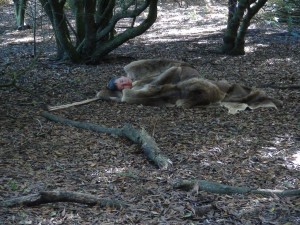
The Lost World (part 1) is the beginning of Julie Gough’s journey into unknown times and places, where artist, becomes detective, archivist, anthropologist, in her search to understand her ancestral past and its effects on the present.
Part 1 takes Gough outside her comfort zone, away from the highly charged sculpture and installation practice for which she is best known, to reasonably uncharted territory in video. The Lost World (part 1) principally consists of video (with works of 10 to 45 minutes), a medium that while providing the artist with a means to explore ephemerality, absence and recurrence, demands commitment from the viewer.
Gough’s journey is set in motion by Observance (2012), a video installation originally shown in the 2012 Adelaide Festival exhibition Deadly: in-between heaven and hell at Tandanya National Aboriginal Cultural Institute. The work is now exhibited as part of a series of large wall-projected videos on the four white walls of Hobart’s CAST gallery. Fittingly, Observance is the first work seen on entering the gallery, projected on the wall opposite the doorway. Here Gough takes the role of detective, surveyor and stalker following and recording unsuspecting eco-tourists around her ancestral land in Mount William National Park. The snippets of surveillance footage, cut into short bites, build a sense of anxiety. The unknowing participants are viewed as if through Gough’s eyes prompting one to question: ‘Who are they?’ ‘Why are they here?’ ‘Are they a threat?’ A sickening reality check of what the ecotourism industry of Tasmania might be reenacting.
Observance sits somewhat separate to the recently developed Lost World collection, which includes The Lost World (part 1) (2013), Oblivion (2013), Traveller (2013) and Haunted (2013). These were created from or in response to the controversial diary of George Augustus Robinson, Friendly Mission, which has become something of a textbook to Tasmania’s colonial history, but as Gough puts it, “Friendly Mission doesn’t allow for a future, just despair.”
In Traveller (2013)Gough takes up the persona of the Traveller, equipped with animal hide and cultural tool kit including screw-together wooden spears. She is depicted trying to hitchhike her way to locations with poignant associations such as The Nut and Highfield House. She is shown ritualistically screwing together her spears (which Gough is renowned for in her sculptural practice) and preying on cattle at Highfield House – a somewhat humourous attempt at hunting. In the next scene she camps out under hides after ceremoniously buries a copy of Friendly Mission, as if putting an end to a nightmare.
Oblivion (2013) is presented on the wall that mirrors Traveller. Here the artist sits completely still on the edge of a waterbed reading Friendly Mission, while leeches burrow beneath the skin of her bare legs. Suffering leech phobia, my stomach turned with fear and repulsion, making me wonder later, was the artist’s reaction to Friendly Mission a similarly physical one? This 45-minute marathon climaxes when a huge tiger leech exits Gough’s skin and a stream of blood rolls down her leg. When queried about the title of the work Gough explained, the artist explained that the title Oblivion was “hardcore – it’s about being stuck in a place, not of this world, and not in a ‘real’ place, while immersed in Friendly Mission.”
In The Lost World (part 1) Gough takes a journey with her brother, searching for a significant and unnamed location. Together they face numerous obstacles: a high-vis-wearing official blocking access, barricaded areas, dangerous water currents, toxic vegetation and the very real risk of being lost in the wilderness. Throughout the work a sense of drama builds. Brother and sister become lost, over 10 hours and miles from their destination. As evening breaks, they receive worried voice messages from their mother, one after another until eventually Constable Wright calls from Devonport Police Station. Sound and video editor Jemma Rea is to be commended: the viewer senses the amount of time lost in the bush, but also the increasing hysteria felt by the hikers and concerned third parties.
Anchoring these four videos is a sculptural cairn/compass built from bluestone spalls installed in the center of the gallery space.A large compass needle moves at random trying in vain to find its bearings. This object has been appropriately titled Haunted (2013), bearing both a material past and the sense of disorientation at not being able to locate oneself. This humble object embodies the aimless helplessness of being lost.
Julie Gough’s investment in her investigation and her personal sacrifice aids in the rewriting of history through the experience of place. She describes her series of actions as “tasks of encounter” undertaken to bring her out of Robinson’s Friendly Mission and back into reality. The artist seeks insight through acts of surveillance, voyeurism, disappearance and physical risk. An unintentional outcome of being lost in a Friendly Mission is that at times the artist and her loved ones experience distress, anxiety and pain – possibly an accurate and challenging retelling of the artist’s ancestral history.
Time travelling exorcism was a commissioned art review of Julie Gough’s The Lost World (part 1) exhibited at CAST gallery 26 April – 26 May 2013 for RealTime issue #115 June-July 2013 pg. 49.